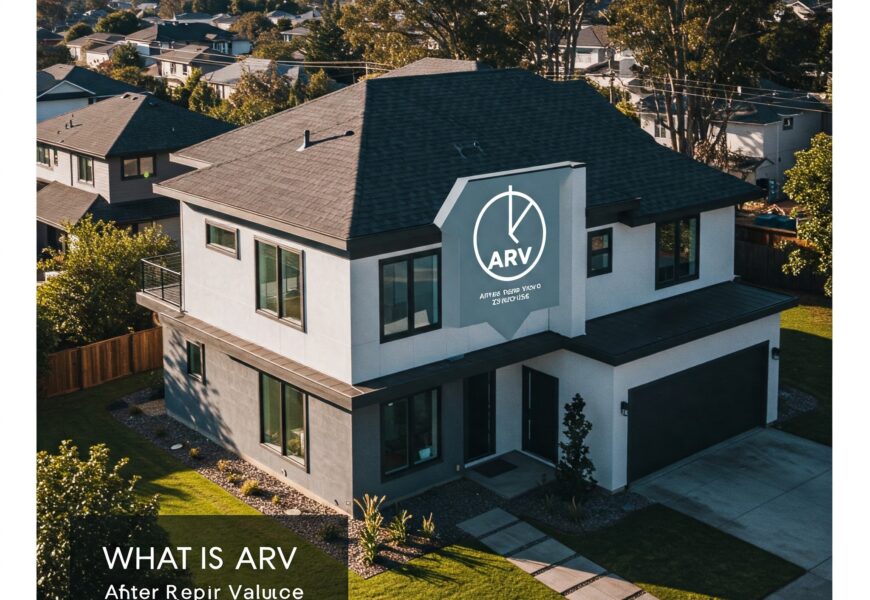ARV, or After Repair Value, is a key concept in real estate investment. It shows how much a property could sell for after repairs and upgrades. Investors use ARV to decide if fixing a home makes financial sense. This guide breaks down its role in buying, renovating, and selling properties effectively.

Key Takeaways
- ARV calculates a property’s value after repairs to guide investment choices.
- It helps investors estimate the profit from renovation projects.
- Accurate ARV assessments avoid overpaying for properties.
- ARV works with other metrics like cost to repair and market trends.
- Mastering ARV improves decision-making for real estate flipping and development.
Introduction to ARV in Real Estate
ARV, or After Repair Value, is key in real estate. It shows a property’s worth after fixes. This figure helps investors know if they’ll make money or lose it.
For both new and experienced investors, ARV is essential. It guides them to success.
Overview of Real Estate Investment and ARV
Real estate investments need accurate valuations. ARV helps by showing a property’s future value. Let’s say you buy a run-down house for $100,000, fix it up for $50,000, and sell it for $250,000.
Importance of ARV in Investment Decisions
ARV stops investors from making big mistakes. Without it, they might spend too much on repairs or miss the market demand. For instance, if repairs cost more than the final sale price, it can lead to financial loss.
Here’s how different factors affect ARV:
| Factor | Influence on ARV |
| Renovation Quality | High-quality upgrades boost ARV more than basic fixes |
| Market Demand | Popular neighborhoods raise ARV significantly |
| Local Regulations | Zoning laws can limit or enhance final value |
ARV also helps with loans. Lenders use it to decide on renovation loans. For sellers, it helps set the right price for their property.
Every step, from planning to negotiating, depends on ARV. It turns risks into chances for profit.
Understanding ARV Real Estate Definition
The ARV real estate definition is about guessing a property’s future value after fixes. It helps investors figure out how much they might make by selling the property after repairs. This is different from regular appraisals because it looks at what the property could be worth later.
Basic Concepts Behind ARV
ARV depends on three main things: where the property is, what repairs it needs, and what’s happening in the local market. Investors figure out if a project is worth it by subtracting repair costs from the ARV. For instance, if a house could sell for $300,000 after fixes and needs $80,000 in repairs, the profit would be $220,000.
Getting these numbers right needs good market data and quotes from contractors.
Historical Context and Evolution
ARV became more popular in the 2000s when flipping houses was all the rage. Back then, people used rough guesses, but now we have tools like Zillow and Redfin for more accurate estimates. Here’s how ARV has changed over time compared to traditional valuations:
| Traditional Valuation | ARV |
| Current condition analysis | Future condition analysis |
| Focuses on existing features | Includes renovation |
| Used for loans and taxes | Guides rehab budgeting |
Today, ARV uses AI to predict how much demand there will be for the property after repairs. This shows how it has moved from a special strategy to a key tool for investors.
Defining What is ARV in Real Estate
Understanding ARV in real estate starts with its main parts. ARV, or After Repair Value, shows a property’s value after fixes are done. It helps investors see how much profit they might make. This value looks at what the property will be worth, not its current price.
Key Terminology Explained
ARV relies on terms like prerepair value (the property’s current state) and rehab costs (the cost of renovations). It also considers equity and cash flow. Knowing these terms helps in making accurate and smart choices.
Differentiating ARV from Other Valuation Metrics
ARV is different from market value, which shows the property’s current state. It’s also different from assessed value, used for taxes. Unlike fair market value, which doesn’t consider renovations, ARV looks at the property’s highest possible value after improvements. This is key for those investing in rehabs.
Calculating ARV: Methods and Formulas
Getting the right ARV involves using formulas and new tech. The arv real estate formula uses data from similar homes. It also considers location and upgrades. Investors use these steps to guess the value after renovations.
| Step | Action |
| 1. Research | Collect sales data from similar homes in the area. |
| 2. Adjust | Modify values based on property condition and upgrades. |
| 3. Compute | Use the arv real estate formula: ARV = (Average comp price) × (Condition adjustment factor). |
Traditional Calculation Techniques
Manual methods use spreadsheets and local market research. Analysts compare recent sales prices. They then adjust for differences like square footage or amenities. This method needs careful data collection but offers detailed insights.
Modern Formulas and Digital Tools
Advanced platforms make calculations easier. Tools like CoStar and Redfin use AI to analyze trends fast. These systems update quickly, showing changes in the market and renovation effects.
| Tool | Features |
| CoStar | Market trend analysis and ARV calculators |
| Zillow | Public MLS data integration |
Both methods use the arv real estate formula but differ in speed and data. Mixing these methods helps get accurate valuations for smart investments.
Factors Influencing ARV in Real Estate
Market trends and property conditions greatly affect after-repair value (ARV). The location, neighborhood demand, and local economic growth all play a part. Properties in booming areas might see higher ARV estimates, while declining regions could see lower ones.
Property age and structural integrity also matter in ARV calculations. Deteriorated roofs or outdated plumbing need expensive repairs, cutting into profits. On the other hand, homes with modern kitchens or energy-efficient systems often sell for more after renovation.
Economic changes like interest rate shifts or job market changes affect buyer affordability. When mortgage rates go up, demand can drop, changing ARV predictions. Local zoning laws or tax policies also impact property appeal and final values.
Investors need to look at supply and demand imbalances. Too many houses in a market can lower ARV, while not enough can raise it. The scope and cost of renovations also adjust ARV estimates, needing careful cost-benefit analysis.
Ignoring these factors can lead to wrong ARV estimates. Accurate assessments combine market data with physical property evaluations. This way, they reflect realistic post-repair values.
Strategies for Finding Profitable ARV Opportunities
Learning how to find arv real estate opportunities starts with taking action. Successful investors do thorough research and observe closely. They look for properties that are underpriced but have great market value.

Market Research Techniques
Start by using tools like Zillow, Realtor.com, or local MLS listings. These help compare recent sales and active listings. Look at neighborhood trends, rental demand, and price changes.
Analyze rehabbed homes to see average returns. Use free resources like county assessor websites. They offer tax records and ownership history, showing hidden gems.
Identifying Undervalued Properties
Focus on homes priced lower than their ARV. Assess renovation needs and location. Look for properties in areas with strong growth.
Check foreclosure listings and short sales. Sellers might undervalue the renovation possibilities. Always compare a property’s current state to its post-renovation value. Use reliable cost estimates for repairs and upgrades.
Step-by-step Guide to Determining ARV
To learn how to determine arv in real estate, follow these steps. Start with a detailed property check and end with the final numbers.
Initial Property Assessment
First, look at the property’s physical state and where it’s located. Note its age, layout, and nearby amenities. Use sites like Zillow or Redfin to compare it with similar homes.
Evaluating Renovation Needs
Make a list of repairs needed, focusing on those that improve looks or function. Get quotes from contractors or use cost-per-square-foot guides. Remember, don’t overdo it compared to the neighborhood.
Final Valuation Process
Put together data from inspections and renovation plans. Use online ARV calculators or get help from licensed appraisers. Check your results against recent sales of similar homes to get the final value.
Leveraging ARV for Real Estate Investing Success
Maximizing profits in arv in real estate investing begins with careful planning. Investors use after repair value (ARV) to match budgets, renovations, and market trends. This ensures their decisions are based on solid data and risks are kept low.
| Step | Action | Benefit |
| 1 | Research local market trends | Identify undervalued properties |
| 2 | Calculate ARV pre-renovation | Set realistic renovation budgets |
| 3 | Compare ARV vs. purchase price | Spot high-potential deals |
Tools like Redfin and Zillow help track comparable sales to refine ARV estimates. By combining ARV with cash flow projections, investors can ensure long-term gains. It’s also wise to verify data with local appraisers to avoid overestimating market value.
“ARV isn’t just a number”
it’s the blueprint for turning properties into profit engines.” – Real estate analyst, National Association of Realtors
By combining arv in real estate investing with hands-on market analysis, investors can build lasting portfolios. Successful strategies focus on properties where the post-renovation value is higher than the upfront costs. This approach turns opportunities into profitable ventures consistently.
Mistakes to Avoid When Calculating ARV
Getting ARV right is all about careful analysis to dodge costly errors. Skipping steps can lead to overestimates or losses. Here’s how to avoid common mistakes when calculating ARV in real estate.
Common Pitfalls in Assumptions
One big mistake is overestimating a property’s value after renovations. Thinking high-demand upgrades will always increase value without checking the market is risky. For example, fancy kitchens might not add much value in areas where people watch their spending.
Another mistake is underestimating renovation costs. This can leave you short on funds.
Ensuring Data Accuracy
Using old comparable sales or incomplete property info can mess up ARV. Stick to recent sales within six months for up-to-date market trends. Also, check permit records and zoning laws to avoid surprise costs.
| Mistake | Solution |
| Ignoring local market trends | Track recent sales and neighborhood growth patterns |
| Using outdated cost estimates | Consult contractor quotes and material price guides |
| Overlooking property-specific issues | Including inspections for structural or environmental risks |

For reliable ARV results, focus on accurate data and realistic assumptions. Double-check every piece of information to match today’s market. This way, you avoid overestimating.
Case Studies: Real-life ARV Application in Investments
Learning what does arv mean in real estate is easier with real examples. These case studies show how ARV helps make smart choices in property investments.
Success Stories and Best Practices
In Chicago, an investor used ARV to flip a 1920s bungalow. They estimated ARV at $450,000 and planned to spend $120,000 on renovations. The house sold for $440,000, proving ARV’s value in setting goals.
Lessons Learned from Challenges
In 2022, a Florida project faced a setback. The ARV was overestimated by 15%, causing losses. The main lesson is to use local market data to match ARV with demand.
| Case Study | Initial ARV Estimate | Outcome | Lesson |
| Chicago Bungalow | $450,000 | $440,000 Sale | Stick to renovation budgets |
| Florida Renovation | $600,000 | $510,000 Sale | Verify market comparable |
These examples show how what does arv mean in real estate leads to real strategies. Accurate ARV assessments lower risks and increase profits with the right market research.
Tools and Resources for Accurate ARV Calculation
Getting to know what ARV means in real estate starts with the right tools. Today’s software and guides make it easy to figure out after-repair value. They help investors compare markets and track renovation costs, leading to accurate estimates.
Recommended Software and Apps
Zillow’s Property Finder app gives quick neighborhood data for ARV comparisons. CoStar and RealPage offer detailed market analytics. Excel templates, like the BiggerPockets ARV Calculator, make cost tracking easy. Mobile apps like Property Sply track local trends in real time.
Helpful Guides and Tutorials
Books like “The Book on Rental Property Investing” by Brandon Turner explain ARV strategies. Online platforms like Udemy have courses on valuation formulas. YouTube channels like Syndicationstellermaster offer free tutorials on using ARV tools.
Conclusion
Learning about ARV is key for real estate investors wanting to grow. It helps find good deals and avoid bad ones. By using tools like CoStar and Zillow, investors can check properties well.
ARV is more than just a number; it’s a guide for smart choices. It helps in fixing up homes or big projects. Even small changes in ARV can lead to big profits.
Staying up-to-date with real estate trends is important. Use online tools to keep track of costs and neighborhood info. This keeps ARV accurate and helps make better decisions.
Are you ready to use these tips? Check your current investments with new ARV methods. Look for free lessons online or get help from local builders. Making smart choices starts with knowing the value of your property.
Frequently Asked Questions
How to calculate ARV in real estate?
First, check the property's current state and estimate repair costs. Next, look at similar properties in the area to see their prices. The formula is: ARV = Current Value + Estimated Repairs + Market Value of Similar Properties.
Why is ARV important in real estate?
ARV is vital for investors. It shows the property's value after fixes, helping investors see if they can make money. This helps them make smart choices.
How to determine ARV in real estate?
Start with the property's current value and repair costs. Then, look at similar properties in the area. This helps set a realistic value after renovations.
What is the ARV real estate formula?
The formula is: ARV = (Price of Comparable Properties) + (Cost of Repairs). It's a simple way to value a property based on repairs and local trends.
How to find ARV real estate data?
You can find ARV data on property websites, local MLS, and real estate software. These tools help investors get the data they need for valuation.
What factors can influence ARV in real estate?
Several things can affect ARV. These include local market trends, property condition, neighborhood appeal, and economic conditions. All these can change a property's value.
What are common mistakes to avoid when calculating ARV?
Avoid overestimating values based on wrong comps. Don't forget to include all repair costs. Also, keep up with market changes to avoid bad investments.




